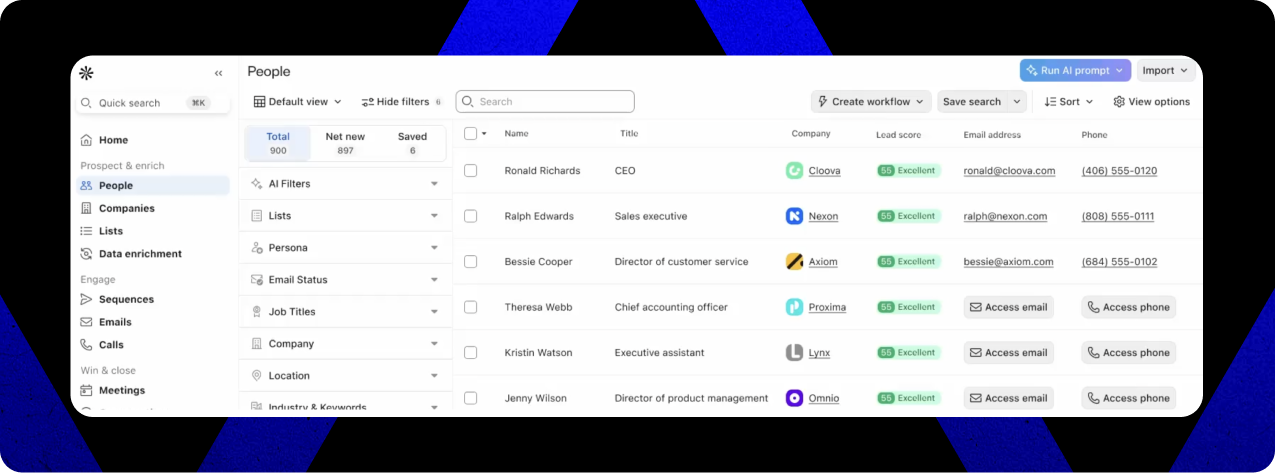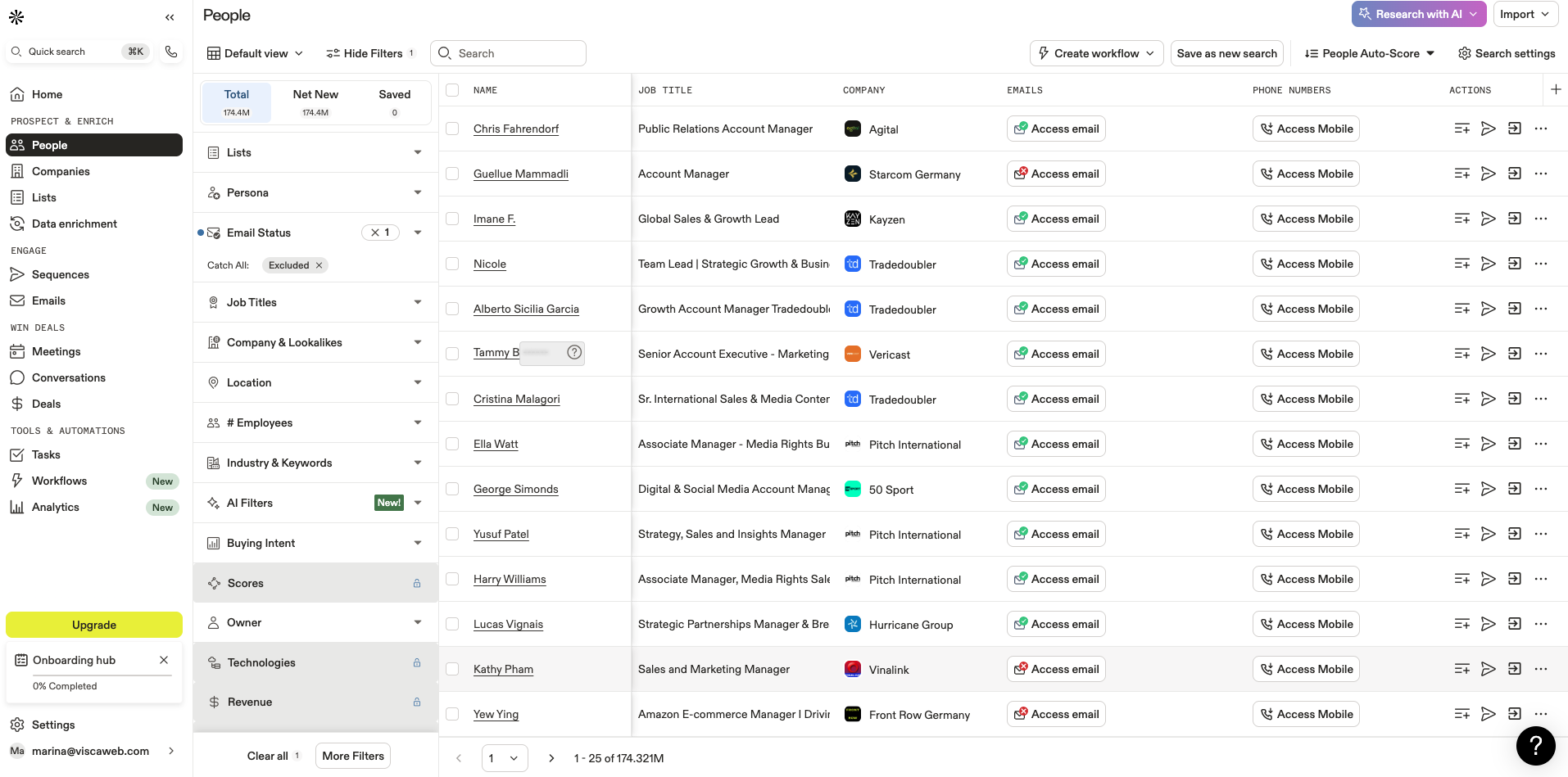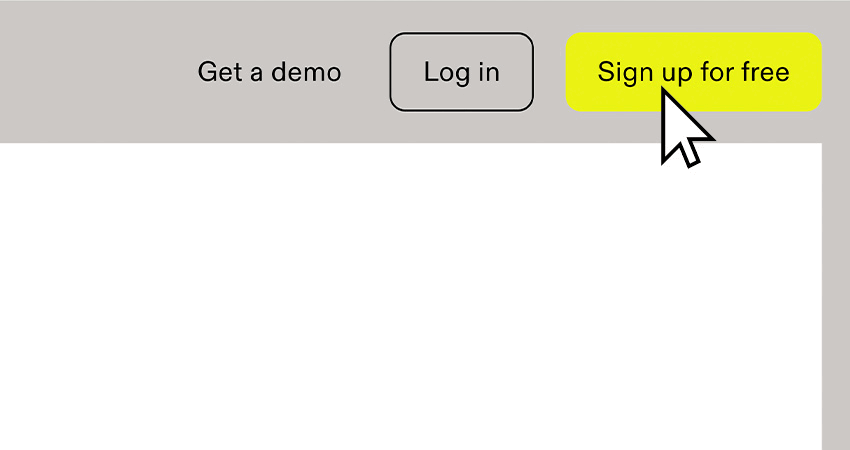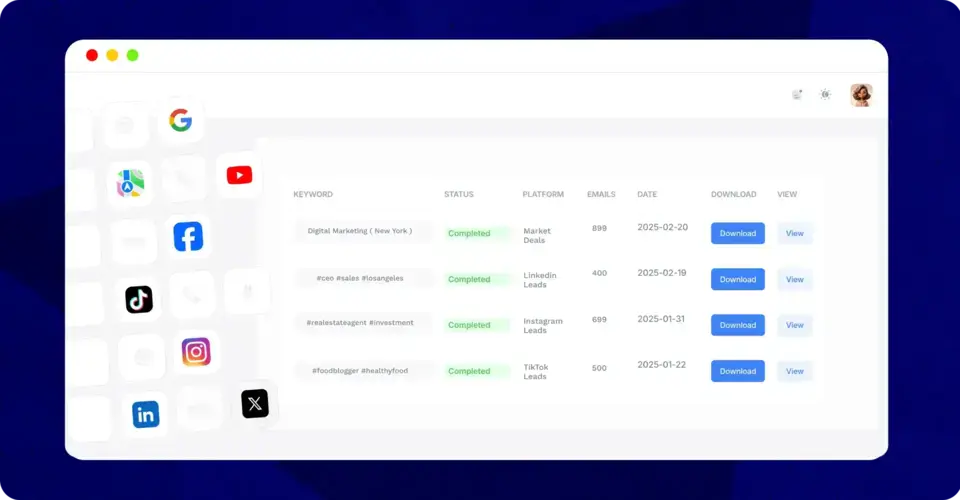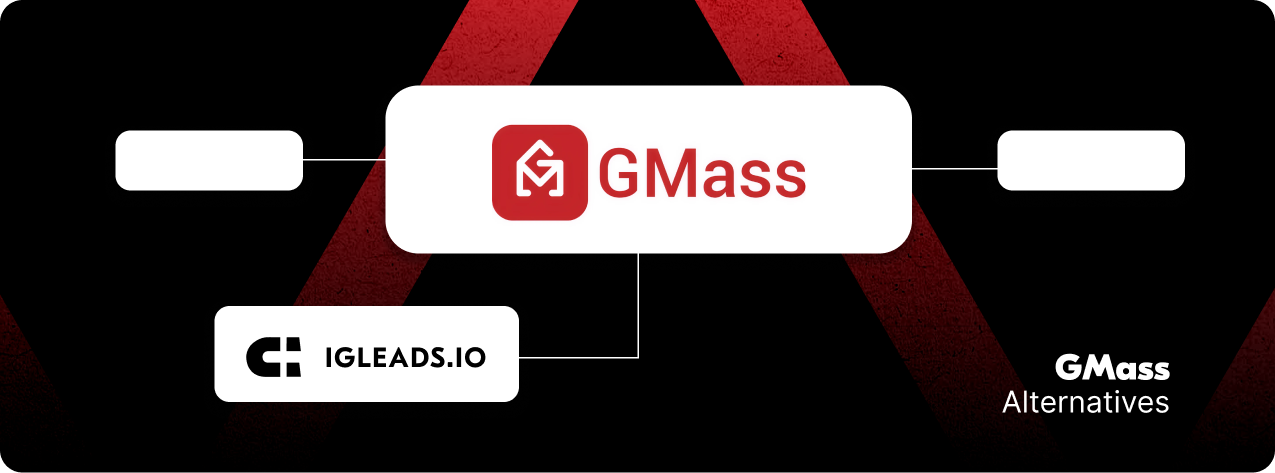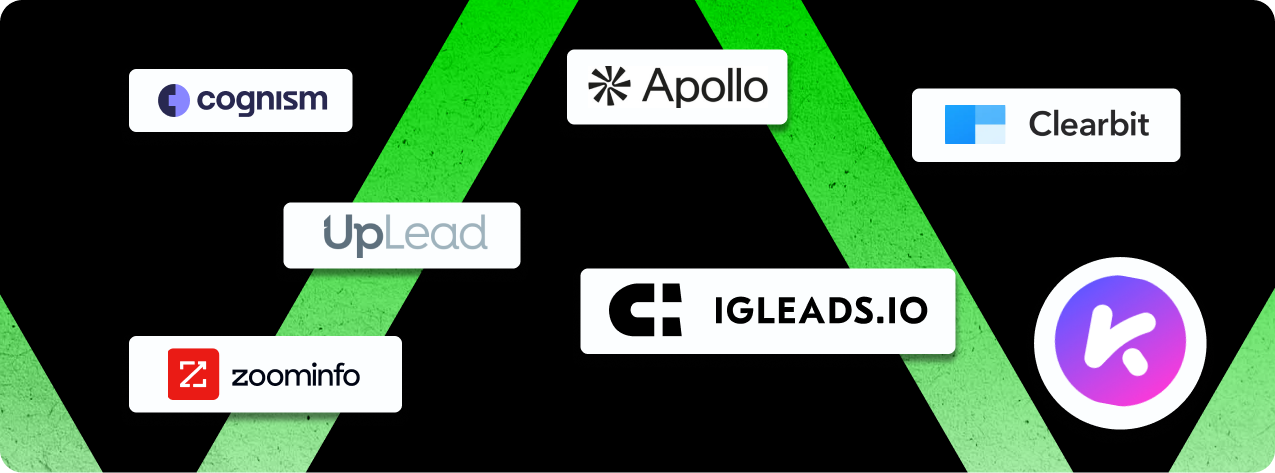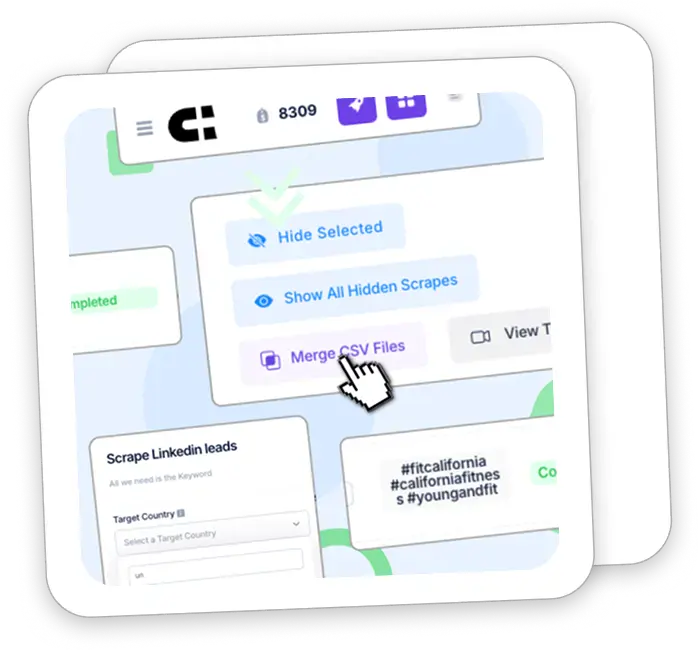Is Apollo.io still good in 2025? Full review & analysis

Apollo.io has dominated the sales intelligence space for years, processing over 500 million emails monthly for over 30,000 companies globally. Each year brings about new questions as to whether it’s still worth the investment or if newer, more focused tools are stealing its thunder.
Pros:
- Powerful email automation
- Massive contact database
- Smooth CRM integration
Cons:
- Disappointing LinkedIn Engagement
- Clunky Chrome Extension
- Questionable Price Value
Our Rating:
- Extensive contact database ⭐⭐⭐⭐
- Integrated dialer ⭐⭐⭐
- LinkedIn engagement ⭐⭐
- CRM Integration ⭐⭐⭐⭐
- Email automation ⭐⭐⭐⭐⭐
- Analytics & Reporting ⭐⭐⭐⭐
- Data Enrichment ⭐⭐⭐
- Chrome Extension ⭐⭐
This isn’t another surface-level review filled with screenshots and feature lists. We’re diving into the real performance data, comparing Apollo against a specialized alternative, and sharing unfiltered feedback from sales teams who’ve actually used it in the trenches.
By the end of this guide, you’ll know exactly whether Apollo deserves your budget or if one of its more nimble competitors is the smarter play for your 2025 sales strategy.
Inside Apollo.io: is it the right tool for your team?
Apollo.io is a sales engagement platform that combines a massive B2B contact database with outreach automation tools. It helps users find verified emails, direct dials, and intent data to target the right prospects. The platform also supports multichannel cadences, making it ideal for outbound sales teams focused on scale and efficiency.
It connects seamlessly with platforms like Salesforce, HubSpot, and LinkedIn, allowing for extensive customization through multistep workflows, contact segmentation, and real-time data enrichment. Although the platform is feature-rich, new users may face a moderate learning curve. Its automation tools are powerful, supporting outreach needs, triggers, and personalized workflows.
Core features of Apollo.io
Here are the standout features Apollo offers in 2025, and how they work (or don’t) depending on your sales strategy:
Extensive contact database ⭐⭐⭐⭐
Apollo.io’s contact database is the core of its value proposition. With over 275 million contact records and 60 million company profiles, it offers one of the most comprehensive lead databases available for B2B sales teams.
Users can drill down into highly specific segments using filters like job title, seniority, company size, industry, revenue, tech stack, geography, and even hiring trends. This makes Apollo particularly powerful for outbound teams that need to balance volume with precision.
What sets Apollo apart is not just the size of the database, but the depth of each contact profile. On average, each lead includes over 200 data points, such as professional history, social links, verified emails, phone numbers, and even tech tools used by their company.
The software’s recent updates have introduced buyer intent signals, allowing users to prioritize leads based on behavior, such as recent funding, job changes, or website engagement.
However, despite its size, Apollo’s data isn’t perfect. Data accuracy remains a concern, especially with older or less active profiles. Verified emails may still bounce, and phone numbers aren’t always up to date. Some users also report a need for manual data cleaning when syncing leads with CRMs like Salesforce or HubSpot, especially after bulk enrichments.
Apollo.io claims a 91% email accuracy rate, supported by a proprietary 7-step verification process and the processing of over 72 million emails each month. However, real-world performance appears more mixed. Independent reviews and user feedback often cite lower accuracy, typically between 65% and 80%.
For example, Salesforge.ai reported data accuracy around 65%, while Skrapp.io rated it 7/10 due to occasional outdated records and bounced emails. GoCustomer.ai also referenced G2 and Reddit users estimating Apollo’s real accuracy closer to 70–80%, with some verified emails still bouncing. In some cases, users on Reddit reported bounce rates as high as 35%, suggesting a notable gap between Apollo’s claims and everyday user experiences.
Integrated dialer ⭐⭐⭐
Apollo’s built-in dialer makes it easy for your team to call prospects directly from the platform—no need to juggle different tools. Every call gets automatically logged and synced to your CRM, which saves time and keeps your records clean. It’s a great feature if cold calling is a big part of your sales process.
You also get helpful extras like local presence (so your number looks local to whoever you’re calling), voicemail drops, and even call recording. Managers can listen in live or coach reps during calls, which is super useful for training and improving performance.
But this tool isn’t for everyone. If your outreach is mostly emails or LinkedIn messages, the dialer might feel like overkill. Call quality can also vary depending on where you’re calling from, so it’s worth testing it in your region. And if you’re not making calls regularly, this feature might just sit there unused—adding complexity to your workflow without much payoff.
LinkedIn engagement ⭐⭐
Apollo.io allows users to create LinkedIn-related tasks as part of their outreach workflows, such as sending connection requests or follow-up messages. These tasks can be added to multistep sequences, helping sales reps stay organized and consistent in their LinkedIn engagement.
The platform also integrates with a Chrome extension, enabling users to interact with LinkedIn profiles while tracking their outreach efforts within Apollo’s interface.
However, unlike more dynamic tools such as IGLeads’ LinkedIn scraper, Apollo’s LinkedIn automation is task-based rather than real-time. The extension doesn’t support live scraping or automated triggers based on user activity, which means all LinkedIn actions—like sending requests or messages—must be manually executed while the browser is open.
There’s no background automation or instant lead capture from LinkedIn profile views or search pages. If your team does high-volume, manual prospecting directly on LinkedIn, Apollo’s approach can feel rigid and less efficient compared to more agile, scraping-based alternatives
CRM Integration ⭐⭐⭐⭐
Apollo.io integrates with the most popular CRMs like Salesforce and HubSpot, allowing for seamless syncing of contact, account, and activity data. This means your prospecting insights, campaign performance, and engagement history automatically feed into your CRM, helping you maintain a unified sales pipeline.
Not only that, the live sync reduces manual data entry, ensuring reps are working with the most up-to-date information, and improving speed-to-follow-up across teams.
For teams working with Salesforce, the integration supports custom fields, opportunity stages, and bidirectional sync, ensuring changes made in either platform stay aligned. HubSpot users benefit from contact enrichment, automated list building, and real-time activity logging inside deals or contact records.
These integrations can be easily configured intuitively through Apollo’s UI without the need for a developer, although more advanced setups may still require admin access.
However, the experience isn’t perfect across the board. Syncing with smaller CRMs or custom-built systems can be more challenging. Apollo doesn’t offer plug-and-play compatibility with every CRM on the market, and for niche platforms, you may need to rely on Zapier or third-party middleware to bridge the gap.
Additionally, improperly configured syncs can lead to data duplication, overwritten records, or missed custom field mappings. The documentation is fairly thorough, but if you don’t know how to code, you may still find the setup process complex without support. These limitations can frustrate users during the onboarding process, especially for lean teams without a dedicated CRM admin
Email automation ⭐⭐⭐⭐⭐
Apollo.io’s email sequencing and automation tools are built to support serious outbound efforts. You can build multistep campaigns using customizable sequences that combine email, call tasks, and even LinkedIn actions. Sequences can branch based on engagement, like opens, clicks, or replies, so you can personalize your follow-ups and guide prospects down different paths.
You can also A/B test subject lines, schedule follow-ups, and adjust sending times based on time zones or working hours to boost response rates.
For teams that need flexibility and scale, Apollo’s sequencing engine is a major asset. It offers powerful conditional logic, engagement tracking, and the ability to pause or tweak campaigns in real time. This makes it great for sales teams that want full control over multichannel outreach and who are willing to fine-tune campaigns to improve performance.
That said, the platform can feel overwhelming if you’re just looking for something quick and lightweight. The interface has a lot of options, and setup can take time. Managing large or complex sequences may require ongoing testing and adjustments, especially if you’re focused on keeping deliverability high.
Analytics & Reporting ⭐⭐⭐⭐
Apollo.io offers in-depth reporting dashboards that give you visibility into key outreach metrics like open rates, reply rates, bounce rates, and overall sequence performance. These insights are valuable for optimizing campaigns, spotting what’s working, and identifying where engagement is dropping off.
You can build custom dashboards tailored to your team’s needs — filtering by rep, industry, company size, or deal stage. Reports can include everything from email metrics and call outcomes to how deals are progressing in relation to specific steps in a sequence.
This level of detail is especially useful for sales teams that track performance closely and want to continually improve their outbound strategy. If you’re managing a large team or running multiple campaigns, Apollo’s reporting helps ensure that no insights slip through the cracks.
For beginners or non-technical people, the dashboards can be seen as “too much” at first. There’s currently no AI-generated summary or simplified overview, so users have to manually dig into the data to find insights. For teams who prefer quick takeaways or more visual analytics, the experience may feel too data-heavy without additional third-party tools.
Data Enrichment ⭐⭐⭐
Apollo.io’s data enrichment feature is a powerful way to breathe new life into outdated or incomplete records. Whether you’re missing verified email addresses, direct dials, job titles, or company details, Apollo can automatically fill in the gaps using data from a wide network of public and proprietary sources. It’s especially useful when your CRM is full of partial contacts or stale leads that need a refresh.
You can trigger enrichment manually for individual records or run it in bulk across your entire database. There are more than 30 different fields, including techno graphics, job changes, demographics, social links, and company growth indicators, helping you get a more complete picture of each lead or account.
The enrichment process is quick and integrates well into sales workflows, making it a favorite among teams that rely on up-to-date, actionable data.
That said, there are a few things to keep in mind. Enrichment credits are tied to your subscription plan, so high-volume usage may require an upgrade. While the data quality is generally strong, not all fields are perfectly mapped to every CRM, which can lead to occasional mismatches.
And if you’re looking for deeper insights like intent data or advanced buying signals, you may need to explore Apollo’s higher-tier plans or integrate with additional tools.
Chrome Extension ⭐⭐
Apollo’s Chrome extension allows users to send LinkedIn connection requests and messages as part of task-based sequences. It’s designed to support multichannel outreach, but the execution feels limited compared to more dynamic tools. Each action must be manually triggered, and the browser must remain open, interrupting flow and requiring constant attention. This can be a tad frustrating.
Moreover, this approach can become a bottleneck for teams that rely heavily on LinkedIn prospecting. The extension lacks real-time automation, background execution, and scraping capabilities, which are increasingly expected in modern outreach workflows.
While it technically covers the LinkedIn channel, its design makes it better suited for low-volume or supplementary use, rather than fast-paced daily prospecting.
How to sign up for Apollo.io
Getting started with Apollo is simple, but a few setup decisions will shape your experience.
- Go to Apollo.io and click “Sign Up Free”.
- Create an account using a business email address (avoid Gmail to access more features).
- Choose a plan – Free is fine to explore, but most users hit credit limits quickly.
- Integrate your email (Gmail/Outlook) and CRM (like HubSpot or Salesforce).
- Import your existing contacts or use Apollo’s search to build a new list.
Apollo.io pricing: is it worth it?
Apollo.io pricing is tiered based on features, monthly credits, and team size, with a mix of free and paid plans. While the Free plan offers limited access, most users quickly hit usage caps and need to upgrade for real prospecting at scale.
Key points about Apollo.io pricing:
- Free Plan: Limited to 10 email credits/day and basic features. Good for testing, but not for teams.
- Basic Plan: Starts at around $49/month per user. Adds more credits and access to enrichment features.
- Professional Plan: From $79/month per user. Includes A/B testing, advanced filters, and job change alerts.
- Organization Plan: Custom pricing. Designed for large teams, with API access, custom roles, and team workflows.
Apollo.io’s pricing depends on your billing cycle (monthly or annual) and how many credits or features you need. Additional costs can arise from overages, long-term contracts, and optional add-ons like API access, all of which can significantly raise the total investment.
IGLeads pricing overview
We won’t sugarcoat it, IGLeads is cheaper, faster, and easier to scale than Apollo.io.
- Monthly Plans: Start at $49/month for access to all scrapers and limited exports
- Unlimited Plan: $249/month for unlimited scrapes and downloads
- Annual Plans: As low as $39/month when billed yearly
Apollo.io reviews: user experiences and feedback
If you’re digging into sales tools, reviews from real users matter way more than polished marketing pages. So, what are people actually saying about Apollo.io in 2025? We looked through dozens of user reviews and Reddit threads to get the real scoop, what people love, what they tolerate, and what drives them nuts.
From solo SDRs to full-on revenue teams, experiences vary, but some clear patterns show up fast. Whether it’s the value for money, credit limitations, or clunky features (hello, LinkedIn integration), these reviews give you a full picture, warts and all. Use this to cut through the noise and decide if Apollo fits your workflow or if it’s time to look elsewhere.
| Apollo.io | Reviews Summary |
| Pros | Cons |
| ✅ Extensive contact database | ⚠️ Data accuracy issues |
| ✅ Advanced filtering capabilities | ⚠️ Limited customer support |
| ✅ Seamless CRM integration | ⚠️ Technical glitches |
| ✅ User-friendly interface | ⚠️ Export limitations |
| ✅ Affordable pricing for SMBs | ⚠️ Email deliverability challenges |
According to sources like Trustpilot, Apollo has a rate of 1,9 over 5 points, based on 754 reviews of customers. Most users in this platform complain about the customer service and price for what they get. In other platforms like Reddit you can find threads of actual users that are happy with the platform, but be careful with those that don’t give a lot of details on their experience.
Same with G2 reviews: Apollo.io gets 4,7/5 stars, with more than eight thousand reviews… Our advice? Trust what you see and the more balanced reviews, and always look for alternatives and comparisons with competitors.
Some of IGLeads users had previously used Apollo.io for their lead generation strategy but as entrepeneurs focused on Social Media, they found our tool was more effective to achieve their goals, and the got also value from our videos and content to enrich their lead gen strategy.
How does Apollo.io compare to IGLeads?
Reading Apollo.io reviews only gives you part of the picture. When you’re in the trenches trying to hit ambitious targets, you need to know how it truly performs against newer, more agile competitors that have entered the market. This is where IGLeads has been turning heads in sales circles.
While Apollo has built its reputation as the enterprise-grade powerhouse with all the bells and whistles, IGLeads.io has carved out its own following for an entirely different reason.
It’s the tool of choice for hustling solopreneurs, growth-focused marketers, and lean sales teams who need results yesterday, not another dashboard to manage or credit system to decipher. The difference isn’t just in features; it’s in philosophy.
Apollo brings the comprehensive artillery, but IGLeads delivers the precision strike when you need to move fast and break through noise without breaking the bank.
IGLeads features and benefits
IGLeads is a data scraping tool built for 2025 outbound workflows. It gives you targeted, real-time lead data from platforms that Apollo doesn’t touch natively, including:
- Instagram (scrape by keyword, hashtag, or location)
LinkedIn (profiles, search pages, Sales Navigator) - Google Maps (local businesses, verified contact data)
- YouTube (creators by niche or video topics)
You don’t need to mess around with APIs or pay extra for enrichment, just pick your target, run a scrape, and download verified leads instantly. It’s as straightforward as it sounds.
IGLeads also includes:
- Built-in email extractor
- Unlimited scrapes (with the right plan)
- Automatic filters by bio keywords, follower counts, location, niche, and more
- Integrations with cold email tools and CRMs via CSV
It’s simple, fast, and works especially well for businesses doing hyper-targeted outreach, like local lead gen, e-commerce, influencer outreach, or B2B prospecting.
How IGLeads complements Apollo.io
Here’s the truth: many teams use both tools.
Apollo excels at structured outreach to known business personas. But it’s less flexible when you want to:
- Test new audiences
- Scrape less traditional platforms (like Instagram)
- Pull leads from local or long-tail niches
- Avoid being locked into a credit-based system
IGLeads helps you fill in the gaps. Let’s see an example: if Apollo is your automated outbound campaign builder, IGLeads is the scalpel you use to cut out niche prospect lists that Apollo can’t see. Think Miami realtors on Instagram, dentists in Toronto via Google Maps, or TikTok creators who’ve posted about “moving soon.”
Combined, they give you volume and precision.
Compare that to Apollo’s tiered plans, overage fees, contact credits, and enterprise contracts, and it’s easy to see why many solo operators and small teams start with IGLeads first.
No seat-based pricing. No hidden fees. No setup calls.
| Feature | Apollo.io | IGLeads |
| Scraping LinkedIn | ✅ | ✅ |
| Scraping Instagram | ❌ | ✅ |
| Scraping Google Maps | ❌ | ✅ |
| Pricing Simplicity | ❌ (tiered + contracts) | ✅ (flat-rate) |
| Lead Export Limits | ⚠️ (per credit) | ⚠️ (unlimited on Unlimited Plan) |
| Built for Niche Segments | ⚠️ (limited) | ✅ |
| Real-Time Filtering | ✅ | ✅ |
| Chrome Extensions | ✅ | ❌ |
For teams that need highly filtered, real-time contact data without the red tape, IGLeads is a no-brainer.
Apollo might still be the go-to for enterprise-style outbound. But if you’re testing fast, running lean, or targeting creative angles, IGLeads will get you there faster, cheaper, and with way less friction.
Is Apollo.io the right fit for you?
If you’re part of a large team running high-volume outbound with detailed workflows and CRM integrations, Apollo can be a game-changer. Its massive contact database, multichannel automation, and sequencing tools are built for scale.
But if you’re a solo founder, freelancer, or running lean with a focus on fast, targeted outreach, Apollo might feel like too much. The platform can be clunky for simple workflows, and while the data is vast, bounce rates on cold lists can still hit 25%. Features like the dialer and LinkedIn tasks are helpful—but not best-in-class.
Pricing starts low, but costs can escalate quickly with enrichment, extra credits, or advanced reporting.
Bottom line: Apollo is powerful, but not lightweight. If you value control, speed, and simplicity, there may be leaner tools that get you results with less overhead.
Related to Apollo io
- Apollo.io vs ZoomInfo: Which sales tool wins on pricing, data, and features in 2025?
- Best 20 Apollo.io alternatives and competitors that actually work
- Apollo.io Chrome Extension Overview and a Better Alternative
- Apollo.io pricing explained and costs breakdown in 2025
Frequently Asked Questions
Yes, but with a caveat. Apollo’s lower-tier plans are relatively affordable and offer good value if you’re a small business that needs basic email outreach and access to a contact database. However, as soon as you need scale, API access, or multi-seat support, costs rise quickly. Many small teams outgrow the free plan fast or run into credit limits that slow things down. If you’re running lean or testing campaigns often, IGLeads.io might be a more flexible option with unlimited scraping and no per-seat pricing.
Apollo’s data is strong, but not perfect. Reviews of Apollo.io often praise the volume of contacts, but data accuracy is hit or miss depending on the niche. Many users report bounce rates from outdated emails or missing phone numbers, especially for smaller or less active businesses. For maximum deliverability, it’s smart to run Apollo data through a validation tool, or pair it with tools like IGLeads, which scrape fresh contact info directly from user-generated platforms like Instagram or Google Maps.
Yes. Apollo integrates with popular CRMs like Salesforce and HubSpot, as well as email tools like Gmail, Outlook, and sequencing platforms. You can automate contact syncing and email tracking directly within the platform. That said, some users report bugs or lag in syncing, so if CRM integration is mission-critical, test this early.
According to hundreds of Apollo.io reviews, users consistently highlight a few standout strengths and frustrations. On the positive side, Apollo is praised for its massive B2B contact database, robust email sequencing capabilities, and seamless integrations with CRMs and calendar tools, making it a solid option for structured outbound workflows. However, many reviews also point to drawbacks, including inconsistent data accuracy, slow or unresponsive customer support, email deliverability challenges (especially without proper warm-up tools), and pricing that quickly escalates as your team or usage scales.
Apollo is a powerful all-in-one tool, but it’s not built for everything. If you’re scraping leads from non-traditional platforms (like TikTok, Instagram, or niche local listings), or if you want fast scrapes without contracts or credit limits, tools like IGLeads.io are a better fit. They’re cheaper, easier to scale, and give you access to untapped lead sources. Still unsure? Book a Demo with IGLeads and see how it stacks up in your workflow.
